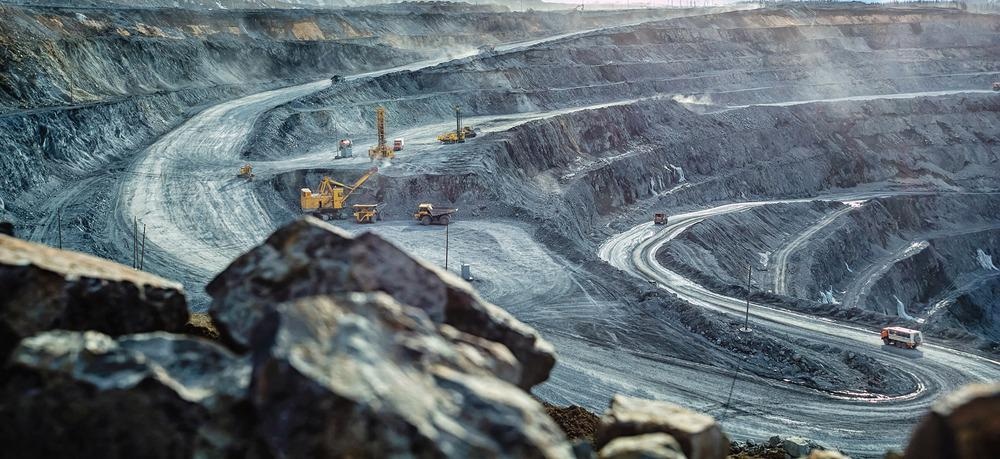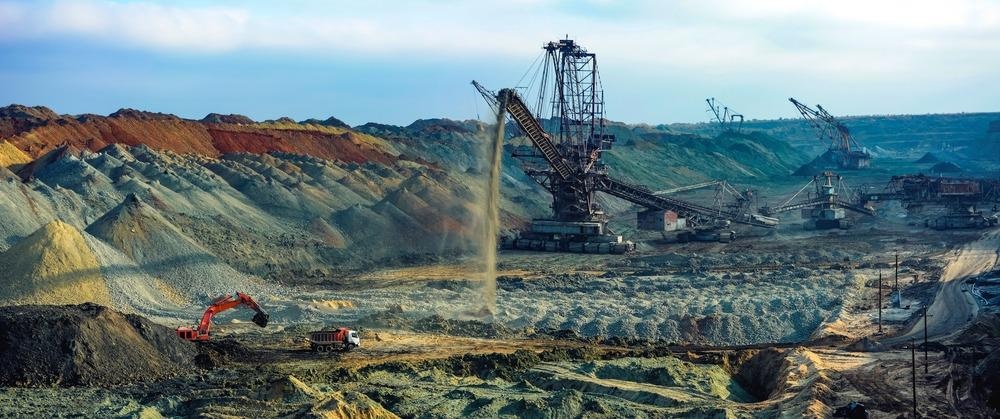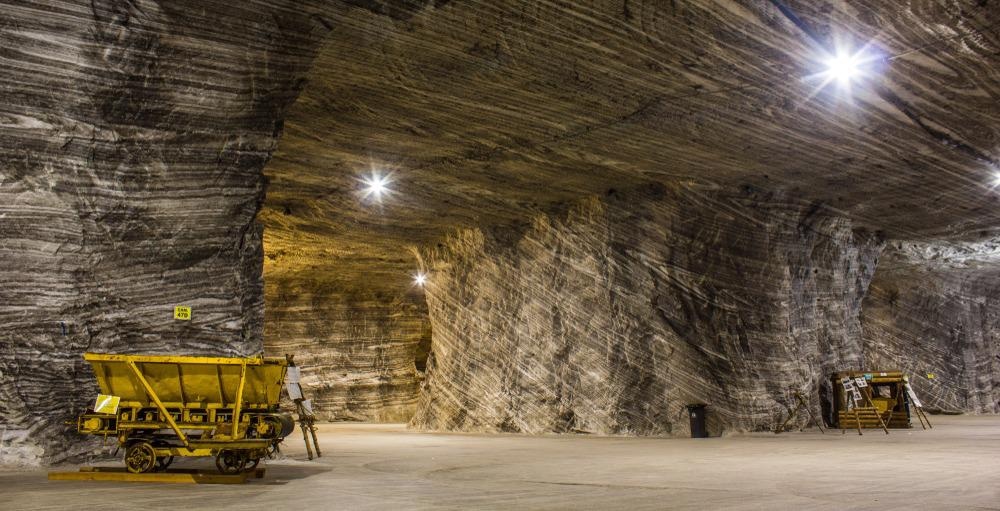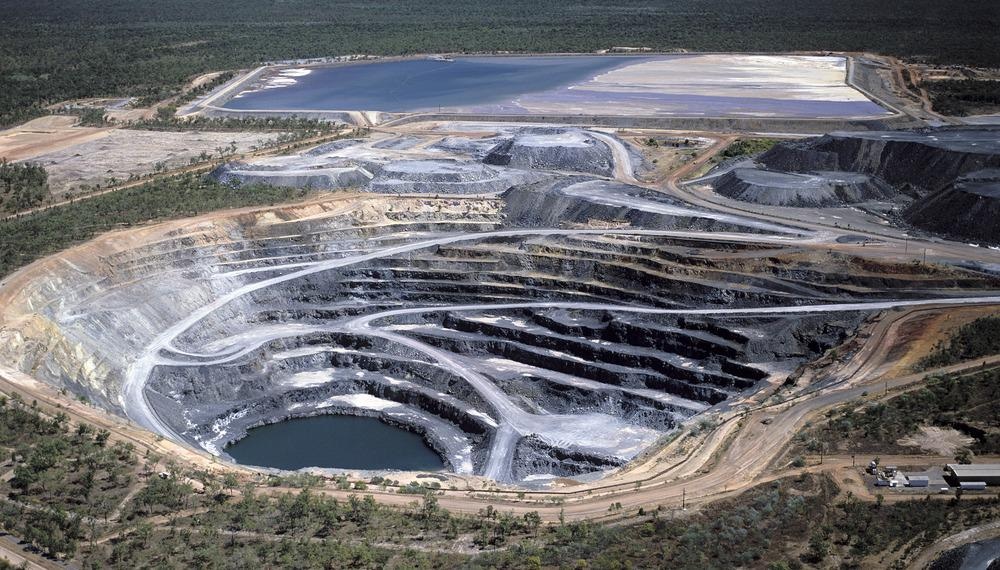Mining has been a cornerstone of global economic activities for millennia, evolving from basic surface extraction to complex underground and quarrying operations. Today, it plays a vital role in industries like electronics and renewable energy, supplying essential resources for technological advancement. However, mining faces significant sustainability challenges as demand grows, balancing economic benefits with environmental impact and resource management.1
This article will provide an overview of some of the main types of mining and how they differ from each other.

Image Credit: Evgeny_V/Shutterstock.com
An Overview of Mining Methods
The choice of mining methods depends on several factors, including the type of mineral, its location, and the quantity of the deposit. Careful planning ensures the economic viability of mining operations.
Surface mining

Image Credit: Romeo Rum/Shutterstock.com
Surface mining/open-pit mining is the oldest form of resource extraction involving minerals from the Earth's surface. While old surface mining methods were labor-intensive, modern techniques utilize heavy machinery to efficiently extract minerals found near the surface or just below ground.
Unlike underground mining, surface mining does not require deep shafts. Instead, it involves removing the overburden, the material covering the coal seam/ore body. This overburden can consist of soil, rocks, or any type of ecosystem.
Surface mining is cost-effective for extracting lower-grade metal ores and industrial minerals near the Earth's surface. Although some minerals are mined without blasting, hard rock typically requires drilling and blasting before extraction.5
Open-pit mines are safer than underground mines, as workers can more easily evacuate disaster sites. However, the danger of open (or borrowed) pits collapsing due to unstable rock faces or explosives remains, so surface pits typically need stepped sides/benches.
Open-pit mines require a significant amount of space, may damage fragile ecosystems, and may contaminate groundwater, facilitating the need for environmental assessments and effective remediation strategies.
Surface mining can displace communities without proper compensation or relocation plans, raising ethical concerns about human rights and social justice.1 Bingham Canyon Mine/Kennedy Copper Mine, Chuquicamata Copper Mine, Udachny Diamond Mine, and Muruntau Mine are notable open-pit mining projects.6
Underground mining

Image Credit: Maria Passer/Shutterstock.com
Underground mines are crucial for extracting mineral deposits deep beneath the Earth's surface. Although technically more challenging, this method remains prevalent in modern resource extraction.
The two main stages in underground mining are development (removing unwanted and non-valuable rock and other components) and production mining (excavating the target resource). Various categories of underground mining exist depending on the processes employed to recover resources, extraction techniques, and shaft type. For instance, horizontal or vertical tunnels, or both, can be used based on those factors.
Mineral type and geology also influence the type of underground mining used. Before an underground mine is excavated, a coal seam or ore body examination must be employed to determine the precise deposit location. This saves unnecessary work and financial expenditure and helps mine planners select the optimal mining technique.
Efficient mine planning helps avoid cave-ins and other disasters that endanger the lives of mine workers. Special equipment is needed, particularly if tunnels must be dug far underground.
Underground mines do not have as large an environmental footprint as surface mines. However, to avoid groundwater contamination risk, assessments must be conducted on the deposit's surrounding geology.
Although underground mining is more expensive than surface mining, it is necessary for profitably mining high-grade metallic ores found deep within the Earth's crust, particularly in large, deep ore bodies. The process involves drilling, blasting, and transporting the extracted rock to the surface for further processing.5
Bulianta Mine, Dataigou Mine, and Anjialing Underground Mine 1 are some of the biggest underground mines in the world.7
In-situ mining/in-situ leach mining

Image Credit: John Carnemolla/Shutterstock.com
This method differs from both underground and surface mining as it does not extract the ore and rock mix for processing at the surface of the mine.
In-situ mining involves using chemical solutions to dissolve the minerals and pump the pregnant solution/solution containing dissolved minerals out of the mine for processing. This type of mining is commonly used to recover uranium due to its dissolvability.
A key consideration in in-situ mining operations is ensuring that the chemical leaching solution does not interact with the surrounding geology or potentially contaminate groundwater. In-situ mining cannot be used for gold, as it is easily dissolved.
Minerals must be permeable to the chemicals used for extraction. This requires evaluating both minerals and the chemical solution to ensure efficient mixing and separation for processing. Specialist equipment must be used to help withstand the harsh chemicals used to extract mineral deposits.
Around 57% of global uranium production now comes from in-situ leach mining. This method is particularly dominant in the United States (US), Kazakhstan, and Uzbekistan.8
Placer Mining

Image Credit: HildeAnna/Shutterstock.com
This mining method exploits unconsolidated minerals mixed with sediments. Rinsing and sifting are commonly employed to remove resources from mixtures. Similar to gold panning, most placer mining operations are conducted in sandy areas and riverbeds where mineral deposits are located.
Gold, precious gemstones, tin, titanium, and platinum are typically recovered from beach dunes and sands using this method. Placer mining is a simple operation, but it requires extensive surveying of the target area to determine the amount of recoverable resources to ensure the economic viability of mining operations. Some areas contain high concentrations of sediments, which can increase the work needed to recover mineral resources.
Other Types of Mining
While these are the four main types of mining, many other methods can be employed depending on the mineral deposit, location, and deposit volume. These include longwall mining, mountaintop removal mining, dredging, highwall mining, block caving, cut-and-fill mining, and room-and-pillar underground mining.
Novel mining methods like biomining and asteroid mining are poised to revolutionize resource extraction. Biomining leverages microorganisms to extract metals from ores, offering a more sustainable and eco-friendly alternative to traditional methods.9,10
Existing biomining operations primarily target metals like gold, nickel, uranium, and copper, which are commonly found in sulfur-bearing minerals. Microbes effectively oxidize sulfidic minerals, converting metals into easily dissolvable forms. The primary environmental concern in biomining is the management of acidic, metal-rich solutions created by microbes, similar to acid mine drainage.9
Similarly, asteroid mining aims to exploit the vast mineral wealth of space, potentially providing rare resources for future technological advancements. Asteroid mining, though costly, offers valuable resources and could mitigate environmental damage caused by conventional mining methods. However, its feasibility remains uncertain due to the significant technological and economic challenges.10
Current Trends and Innovations in Mining Technologies
Recent advancements in mining technologies based on automation, artificial intelligence (AI), and sustainable practices are revolutionizing the sector.
Automation is improving efficiency and safety by reducing human labor in hazardous environments, while artificial intelligence (AI) is enhancing ore processing and predictive maintenance.11
AI and machine learning can be applied to every mining stage, from initial prospecting and exploration to production and finally to mine closure and reclamation. For instance, mineral resource evaluation can be effectively performed using an artificial neural network (ANN)-based model for a bauxite deposit.11
Similarly, specific fuzzy-based models can generate a mineral prospectivity map. These models utilize geochemical and geological data for gold deposits and geological, magnetic, and satellite data for Mississippi valley-type deposits, respectively. Computer software designated as equipment selection (EQS) has been developed to automate the mining equipment selection process based on the fuzzy set theory.11
Although autonomous haul truck technology has shown promising results, it will fully realize its potential with real-time, smart computational analysis of data from the environment and nearby machines. Recently, dragline automation was achieved using the deep learning approach with convolutional neural networks for object detection and terrain recognition tasks in mining excavation operations.11
Green mining/sustainable mining prioritizes environmental protection, economic viability, and social responsibility, promoting a more eco-friendly approach to resource extraction. It aims to minimize environmental impact, ensure worker and community safety, and maximize long-term economic benefits. Key environmental goals include habitat preservation and reducing land, air, and water pollution.12
Several studies have proposed innovative techniques for effective mining waste management to enhance environmental protection. For instance, advanced water treatment methods like electrocoagulation, ion exchange, and nanotechnology prevent chromium percolation from mine wastewater into the surrounding environment, which endangers fauna and flora.12
Trends in mining operations are increasingly focused on sustainability, such as integrating electric vehicles (EVs) to reduce emissions and improve energy efficiency. EVs offer several advantages over diesel vehicles commonly used in mining, including constant torque, higher energy efficiency, less maintenance, less vibration and noise level, better overload capacity, quick response to the load, no exhaust fumes, less heat generation, and lower operational costs.13
Advancements in mineral recovery techniques, including improved flotation and hydrometallurgical processes, enhance resource extraction while minimizing waste. These innovations are reshaping the industry toward more eco-friendly and efficient practices.14
Environmental and Social Impacts of Mining
The environmental and social impacts of mining have led to an increased focus on remediation techniques and sustainable practices. Efforts are being made to reduce the ecological footprint of mining by implementing advanced technologies for land restoration, water management, and minimizing pollution.15-18
The major environmental issues in mining include groundwater and surface contamination of heavy metals and due to acid mine drainage, sedimentation of mountain streams, changing groundwater regime, landscape alteration, and ecological disturbance. Land restoration is essential for sustainable mining practices.15,16
Successful mine reclamation projects prioritize landscape rehabilitation, ecosystem restoration, and soil improvement. A leading example is the transformation of CalPortland Cement's former sand and gravel mining site in Steilacoom, Washington, into the renowned Chambers Bay Golf Course, which hosted the 2015 U.S Open.16
Similarly, the treatment of contaminated water primarily involves removing heavy metals and neutralizing acidity. Approaches like diverting surface runoff away from waste piles reduce the ecological footprint of mining.15 Metagenomics and phytoremediation are gaining prominence as ecologically sustainable techniques for mine tailing rehabilitation.17
Plant species like Prosopis tamarugo, Maireana brevifolia, Pennisetum purpureum, Polygonum capitatum, Lolium perenne, and Festuca arundinacea could be used for the remediation of mine tailings.17 Nano-enhanced materials can also be used for the remediation of mine-polluted soil.18 For instance, a study published in Chemosphere evaluated the effect of iron oxide and zero-valent I nanoparticles in reducing soil contamination. Results showed that iron oxide dosages significantly reduced the easily accessible arsenic in the soil.18
Emerging Resources in Mining
The demand for rare earth elements, lithium, copper, nickel, cobalt, and other critical minerals is rapidly increasing due to their crucial role in powering clean energy technologies like EVs, wind turbines, and solar panels.19
While critical minerals are essential for a clean energy transition, their extraction and processing must be managed responsibly to prevent environmental and social issues like greenhouse gas emissions, pollution, biodiversity loss, and human rights abuses.19
As global energy transitions toward sustainability, traditional mining faces challenges related to environmental impact and resource scarcity. In response, urban mining, which involves recycling metals from electronic waste, has emerged as a key strategy to secure these vital materials sustainably and reduce reliance on virgin mining.20
Conclusion
Mining is crucial in providing the essential materials to drive the global economy and facilitating the transition to clean energy. However, as the demand for critical minerals grows, addressing the environmental and social challenges associated with extraction is vital.
Innovations in mining methods and a focus on sustainability and recycling through urban mining offer promising solutions for more responsible resource management. By balancing technological advancement with ecological and ethical considerations, the industry can contribute to a greener, more sustainable future.
References and Further Reading
- Carvalho, F. P. (2017). Mining industry and sustainable development: Time for change. Food and Energy Security, 6(2), 61-77. DOI: 10.1002/fes3.109, https://onlinelibrary.wiley.com/doi/full/10.1002/fes3.109
- 10 Different Types of Mining Operations and Mines [Online] Available at https://nayturr.com/types-of-mining/
- The Four Main Types of Mining [Online] Available at https://anundergroundminer.com/blog/the-four-main-types-of-mining
- Types of Mining Methods [Online] Available at https://www.cummins.com/engines/mining/types-of-mining
- How do we extract minerals? [Online] Available at https://www.usgs.gov/faqs/how-do-we-extract-minerals (Accessed on 19 December 2024)
- Top 10 deep open-pit mines [Online] Available at https://www.mining-technology.com/features/feature-top-ten-deepest-open-pit-mines-world/ (Accessed on 19 December 2024)
- The ten biggest underground mines in Asia-Pacific [Online] Available at https://www.mining-technology.com/marketdata/ten-biggest-underground-mines-in-operation-inasia-pacific/ (Accessed on 19 December 2024)
- In-Situ Leach Mining of Uranium [Online] Available at https://world-nuclear.org/information-library/nuclear-fuel-cycle/mining-of-uranium/in-situ-leach-mining-of-uranium (Accessed on 19 December 2024)
- What is biomining? [Online] Available at https://www.americangeosciences.org/critical-issues/faq/what-biomining (Accessed on 19 December 2024)
- Yarlagadda, S. (2022) Economics of the Stars: The Future of Asteroid Mining and the Global Economy [Online] Available at https://hir.harvard.edu/economics-of-the-stars/ (Accessed on 19 December 2024)
- Ali, D., Frimpong, S. (2020). Artificial intelligence, machine learning and process automation: Existing knowledge frontier and way forward for mining sector. Artificial Intelligence Review, 53(8), 6025-6042. DOI: 10.1007/s10462-020-09841-6, https://link.springer.com/article/10.1007/s10462-020-09841-6
- Onifade, M. et al. (2024). Advancing toward sustainability: The emergence of green mining technologies and practices. Green and Smart Mining Engineering, 1(2), 157-174. DOI: 10.1016/j.gsme.2024.05.005, https://www.sciencedirect.com/science/article/pii/S2950555024000338
- Grycan, W. (2022). Electric vehicles in mining for the aspect of operational safety. Prz. Elektrotechniczny, 110-113. http://pe.org.pl/articles/2022/12/27.pdf
- Anderson, C. G., & Cui, H. (2024). Advances in Mineral Processing and Hydrometallurgy: 2nd Edition. Metals, 14(12), 1347. DOI: 10.3390/met14121347, https://www.mdpi.com/2075-4701/14/12/1347
- Mining Remediation Technology Developments and Information Developments and Information Resources [Online] Available at https://www.clu-in.org/romania/presentations/kovalickminingresources.pdf (Accessed on 19 December 2024)
- Healing the Earth: Exploring Environmental Remediation Strategies [Online] Available at https://unity.edu/distance-education-blogs/environmental-remediation/ (Accessed on 19 December 2024)
- Hassan, S. et al. (2024). Revitalizing contaminated lands: A state-of-the-art review on the remediation of mine-tailings using phytoremediation and genomic approaches. Chemosphere, 356, 141889. DOI: 10.1016/j.chemosphere.2024.141889, https://www.sciencedirect.com/science/article/abs/pii/S0045653524007823
- Ji, M., AL-Huqail, A. A., Majdi, A., Liu, H., Ali, I., & Marzouki, R. (2022). Remediation of mine polluted soil with nano-enhanced materials: Development of extreme learning machine approaches. Chemosphere, 307, 135772. DOI: 10.1016/j.chemosphere.2022.135772, https://www.sciencedirect.com/science/article/abs/pii/S0045653522022652
- Critical Energy Transition Minerals [Online] Available at https://www.unep.org/topics/energy/renewable-energy/critical-energy-transition-minerals (Accessed on 19 December 2024)
- What is urban mining – and why do we need to do more of it? [Online] Available at https://www.weforum.org/stories/2023/11/urban-mining-circular-economy-ewaste/ (Accessed on 19 December 2024)
Disclaimer: The views expressed here are those of the author expressed in their private capacity and do not necessarily represent the views of AZoM.com Limited T/A AZoNetwork the owner and operator of this website. This disclaimer forms part of the Terms and conditions of use of this website.